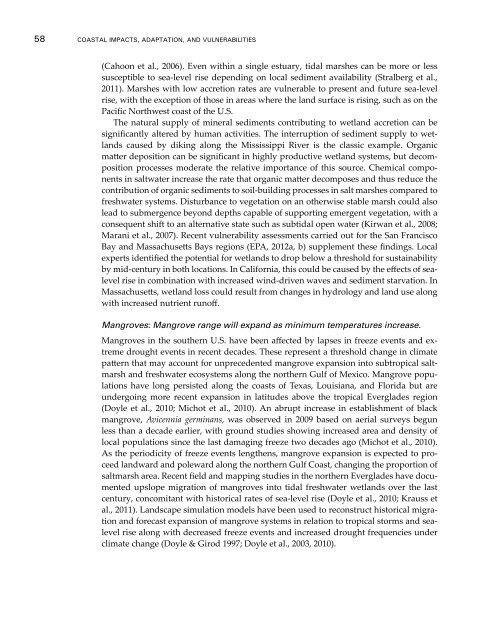Coastal Impacts, Adaptation, and Vulnerabilities - Climate ...
Coastal Impacts, Adaptation, and Vulnerabilities - Climate ...
Coastal Impacts, Adaptation, and Vulnerabilities - Climate ...
You also want an ePaper? Increase the reach of your titles
YUMPU automatically turns print PDFs into web optimized ePapers that Google loves.
58 <strong>Coastal</strong> <strong>Impacts</strong>, <strong>Adaptation</strong>, <strong>and</strong> <strong>Vulnerabilities</strong>(Cahoon et al., 2006). Even within a single estuary, tidal marshes can be more or lesssusceptible to sea-level rise depending on local sediment availability (Stralberg et al.,2011). Marshes with low accretion rates are vulnerable to present <strong>and</strong> future sea-levelrise, with the exception of those in areas where the l<strong>and</strong> surface is rising, such as on thePacific Northwest coast of the U.S.The natural supply of mineral sediments contributing to wetl<strong>and</strong> accretion can besignificantly altered by human activities. The interruption of sediment supply to wetl<strong>and</strong>scaused by diking along the Mississippi River is the classic example. Organicmatter deposition can be significant in highly productive wetl<strong>and</strong> systems, but decompositionprocesses moderate the relative importance of this source. Chemical componentsin saltwater increase the rate that organic matter decomposes <strong>and</strong> thus reduce thecontribution of organic sediments to soil-building processes in salt marshes compared tofreshwater systems. Disturbance to vegetation on an otherwise stable marsh could alsolead to submergence beyond depths capable of supporting emergent vegetation, with aconsequent shift to an alternative state such as subtidal open water (Kirwan et al., 2008;Marani et al., 2007). Recent vulnerability assessments carried out for the San FranciscoBay <strong>and</strong> Massachusetts Bays regions (EPA, 2012a, b) supplement these findings. Localexperts identified the potential for wetl<strong>and</strong>s to drop below a threshold for sustainabilityby mid-century in both locations. In California, this could be caused by the effects of sealevelrise in combination with increased wind-driven waves <strong>and</strong> sediment starvation. InMassachusetts, wetl<strong>and</strong> loss could result from changes in hydrology <strong>and</strong> l<strong>and</strong> use alongwith increased nutrient runoff.Mangroves: Mangrove range will exp<strong>and</strong> as minimum temperatures increase.Mangroves in the southern U.S. have been affected by lapses in freeze events <strong>and</strong> extremedrought events in recent decades. These represent a threshold change in climatepattern that may account for unprecedented mangrove expansion into subtropical saltmarsh<strong>and</strong> freshwater ecosystems along the northern Gulf of Mexico. Mangrove populationshave long persisted along the coasts of Texas, Louisiana, <strong>and</strong> Florida but areundergoing more recent expansion in latitudes above the tropical Everglades region(Doyle et al., 2010; Michot et al., 2010). An abrupt increase in establishment of blackmangrove, Avicennia germinans, was observed in 2009 based on aerial surveys begunless than a decade earlier, with ground studies showing increased area <strong>and</strong> density oflocal populations since the last damaging freeze two decades ago (Michot et al., 2010).As the periodicity of freeze events lengthens, mangrove expansion is expected to proceedl<strong>and</strong>ward <strong>and</strong> poleward along the northern Gulf Coast, changing the proportion ofsaltmarsh area. Recent field <strong>and</strong> mapping studies in the northern Everglades have documentedupslope migration of mangroves into tidal freshwater wetl<strong>and</strong>s over the lastcentury, concomitant with historical rates of sea-level rise (Doyle et al., 2010; Krauss etal., 2011). L<strong>and</strong>scape simulation models have been used to reconstruct historical migration<strong>and</strong> forecast expansion of mangrove systems in relation to tropical storms <strong>and</strong> sealevelrise along with decreased freeze events <strong>and</strong> increased drought frequencies underclimate change (Doyle & Girod 1997; Doyle et al., 2003, 2010).
















